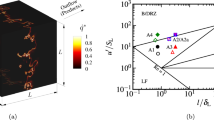Abstract
The propagation of a combustion wave over a shallow hot liquid (n-butanol) blown over by an air flow was studied experimentally. The flame spread was accompanied by pulsations, whose amplitude depended on the oncoming gas velocity. Dependences of the average flame speed on temperature and oncoming gas velocity were obtained. The average speed was found to be independent of the liquid depth ahead of the flame within the experimental error.
Similar content being viewed by others
References
P. L. Garcia-Ybarra, J. L. Castillo, J. C. Antoranz, V. Sankovitch, and J. San Martin, “Study of the thermocapillary layer preceding slow, steadily spreading flames over liquid fuels,” in: Twenty-Sixth Symp. (Int.) on Combustion, Combustion Inst. (1996), pp. 1469–1475.
H. D. Ross and F. J. Miller, “Detailed experiments of flame spread across deep butanol pools,” ibid., pp. 1327–1334.
D. N. Schiller and W. A. Sirignano, “Opposed-flow flame spread across n-propanol pools,” Proc. Combust. Inst., 26, 1319–1325 (1996).
D. N. Schiller, H. D. Ross, and W. A. Sirignano, “Computational analysis of flame spread across alcohol pools,” Combust. Sci. Technol., 118, 203–255 (1996).
K. Takahashia, A. Itoa, Y. Kudoa, T. Konishib, and K. Saitoc, “Scaling and instability analyses on flame spread over liquids,” Proc. Combust. Inst., 30, 2271–2277 (2005).
K. Takahashi, Y. Kodaira, Y. Kudo, A. Ito, and K. Saito, “Effect of oxygen on flame spread over liquids,” Proc. Combust. Inst., 31, 2625–2631 (2007).
D. N. Schiller and W. A. Sirignano, “Opposed-flow flame spread across n-propanol pools,” in: Twenty-Sixth Symp. (Int.) on Combustion, Combustion Inst. (1996), pp. 1319–1325.
A. A. Korzhavin, V. A. Bunev, I. G. Namyatov, and V. S. Babkin, “Flame spread over liquid fuel films on metallic substrates,” Combust. Expl., Shock Waves, 36, No. 3, 304–309 (2000).
I. G. Namyatov, S. S. Minaev, V. S. Babkin, V. A. Bunev, and A. A. Korzhavin, “Diffusion combustion of a liquid fuel film on a metal substrate,” Combust., Expl., Shock Waves, 36, No. 5, 562–570 (2000).
A. A. Korzhavin, V. A. Bunev, I. G. Namyatov, S. S. Minaev, and V. S. Babkin, “Combustion regimes of liquid fuel film on thermally thin metallic substrate,” in: D. Bradley, D. Drysdale, and G. Makhviladze (eds.), Fire and Explosion Hazard, Proc. of the 3rd Int. Seminar on Fire and Explos. Hazards, Center for Res. in Fire and Explosion Studies, Preston (2001), pp. 379–388.
A. N. Baratov and A. Ya. Korol’chenko (eds.), Fire and Explosion Hazard of Substances and Materials and Means of Their Suppression [in Russian], Book 1, Khimiya, Moscow (1990), p. 193.
K. Torrance and R. L. Mahajan, “Fire spread over liquid fuels: Liquid phase parameters,” in: Fifteenth Symp. (Int.) on Combustion, Combustion Inst., Pittsburgh (1975), p. 281–287.
Author information
Authors and Affiliations
Corresponding author
Additional information
__________
Translated from Fizika Goreniya i Vzryva, Vol. 44, No. 1, pp. 29–34, January–February, 2008.
An erratum to this article is available at http://dx.doi.org/10.1007/s10573-008-0046-5.
Rights and permissions
About this article
Cite this article
Zamashchikov, V.V. Flame spread over a liquid surface in a channel of finite section under oncoming air-flow conditions. Combust Explos Shock Waves 44, 25–30 (2008). https://doi.org/10.1007/s10573-008-0005-1
Received:
Issue Date:
DOI: https://doi.org/10.1007/s10573-008-0005-1




